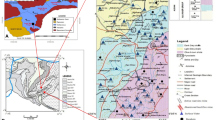Abstract
The effects of uptake of metals (iron, zinc, cadmium and chromium) by juvenile snail Limicolaria aurora fed edible mushroom Pleurotus spp from 3 contaminated farm sites and a laboratory grown species (control) respectively were investigated. The 120 snails were fed in plastic snaileries for 4 weeks in the laboratory. Control site was risk free. Metal uptake was low and bioaccumulation in L. aurora tissue was below FAO/WHO standard of 1 mg/kg for chromium and cadmium. Snails were considered safe for consumption.
Similar content being viewed by others
References
Adejumo TO, Awosanya OB (2011) Proximate and mineral composition of four edible mushroom species from south western Nigeria. Afr J Biotech 4(10):1084–1088
Anderson A, Lykke SE, Lange M, Bech K (1982) Trace elements in edible mushrooms. Publication 68 Levene Middle Inst, Stat
Aruguette DM, Aldstadt JH, Mueller GM (1998) Accumulation of several heavy metals and lanthanides in mushrooms (Agaricales) from the Chicago region. Sci Total Environ 224:43–45
Berner LA, Millers SD (1985) Effects of dietary proteins on Fe bioavailability in a review. Fd Chem 18(1):47–69
Brooks AW, White KN, Bailey SE (1992) Accumulation and excretion of Al and Fe by terrestrial snail Helix aspersa. Comp Biochem Physiol 103:577–583
Cibulka J, Sisak L, Pulkerab K, Micholoea D, Seakova J, Fucikora A (1996) Cadmium, lead and caresium levels in wild mushrooms and forest barriers from different localities of the Czech Republic. Sci Agric Biochem 27:113–129
Clark J, Fairbrother A, Kapustka LA (2000) Acclimation and adaptation of terrestrial organisms to metals in soil. International Copper Association, New York
Dallinger R, Rainbow PS (1993) Ecology of metals in invertebrates. Lewis Publishers, Boca Raton
Ebenso IE, Ebenso GI (2011) Childhood risk estimation of lead metal poisoning from edible land snail at abandoned battery factory environment. Ethiop J Environ Stud Manag 4(3):73–77
Ebenso IE, Ologhobo AD (2008) Effects of lead pollution from vehicular exhaust fumes against sentinel juvenile Achatina achatina. Bull Environ Contam Toxicol 81(5):513–515
Ebenso IE, Ologhobo AD (2009) Effects of lead pollution at industrial contaminated sites on sentinel juvenile Achatina achatina. Bull Environ Contam Toxicol 82(1):106–110
Ebenso IE, Ologhobo AD (2010) Evaluation of lead exposure using Achatina achatina (Linné 1758) at varying traffic intensity. Niger Fd J 28(1):2–6
FAO/WHO (Food and Agriculture Organization/World Health Organization) (2001) List of maximum levels recommended for contaminants/food standard by Joint FAO/WHO Codex Alimentarius Commission. Joint Office, The Netherlands
Ge Y, Murray P, Hendershot WH (2000) Trace metal speciation and bioavailability in urban soils. Environ Pollut 107:137–144
Ghosh D (2004) Algae and fungi as food. Resonance 5:33–40
Gomot A (2000) Standardized growth toxicity testing (Cu, Zu, Pb, and pentachlorophenol) with Helix aspersa. Ecotoxicol Environ Saf 46:41–50
Hopkin SL (1989) Ecophysiology of metals in terrestrial invertebrates. Elsevier Applied Science, New York
Isildak O, Turkekul I, Elmastas M, Tuzea M (2004) Analysis of heavy metals in some wild grown edible mushrooms from the middle black sea region, Turkey. Fd Chem 86:547–552
Ita BN, Essien JP, Ebong GA (2006) Heavy metal levels in fruiting bodies of edible and non-edible mushrooms from the Niger Delta Region of Nigeria. J Agric Soc Sci 2(2):84–87
Ita BN, Ebong GA, Essien JP, Edouk SI (2008) Bioaccumulation potentials of heavy metals in edible fungal saporocarps from Niger Delta Region of Nigeria. Pak J Nutr 7(1):93–97
Kalac P, Suoboda L (2000) A review of trace element concentrators in edible mushrooms. Fd Chem 69(3):273–281
Keller HW, Snell KL (2002) Feeding of slugs on mycomycetes and macro fungi. Mycologia 94(5):757–760
Laskwoski R, Hopkins SP (1996) Accumulation of Zn, Cu, Pb and Cd in garden snail Helix aspersa: implication for predators. Environ Pollut 91(3):289–297
Manjunathan J, Susbulahshma N, Shanmngapriya R, Kaviyarasan M (2011) Proximate and mineral composition of four edible mushroom species from south India. Int J Biod Conserv 3(8):386–388
Odunaiya O, Akinyemi AA (2008) Performance of two snail species Archachatina marginata and Achatina achatina raised under the same management practices. Niger J Ani Prod 35(2):224–229
Oei P (2003) Mushroom cultivation, appropriate technology for mushroom growers. Backhugs Publishers, The Netherlands
Omole JA, Tewe OO, Adeborate EA, Oluokun JA, Ogundola FI, Nworgu EC (2000) Performance of different breeds of snails under the same management conditions. Trop J Anim Sci 3(1):133–138
SAS (Statistical Analysis System) (1999) Guide for personal computer. Version 6. SAS Institute, New York
Turkenkul I, Elmastas M, Tuzen M (2004) Determination of iron, copper, manganese, zinc, lead and cadmium in mushroom samples from Tokat, Turkey. Fd Chem 84:389–392
Tuzen M, Ozdemir M, Demirbas A (1998) Study of some heavy metals in some cultivated mushrooms of Turkish origin. Fd Chem 63:247–251
Author information
Authors and Affiliations
Corresponding author
Rights and permissions
About this article
Cite this article
Ebenso, I.E., Solomon, I.P., Akoje, C.C. et al. Bioaccumulation of Iron, Zinc, Cadmium and Chromium by Juvenile Snail Limicolaria aurora J., Fed Edible Mushroom Pleurotus spp from Niger Delta, Nigeria. Bull Environ Contam Toxicol 90, 314–317 (2013). https://doi.org/10.1007/s00128-012-0920-4
Received:
Accepted:
Published:
Issue Date:
DOI: https://doi.org/10.1007/s00128-012-0920-4




